An AMD Threadripper X399 Motherboard Overview: A Quick Look at Seven Products
by Ian Cutress & Joe Shields on September 15, 2017 9:00 AM ESTASUS
ASUS enters the Threadripper arena with two motherboards available at launch: the Republic of Gamers Zenith Extreme and the Prime X399-A. A third board, the ROG Strix X399-E, is set to follow.
ASUS Republic of Gamers (ROG) X399 Zenith Extreme
The first board, the ROG Zenith Extreme, is positioned at the top of the ASUS X399 product stack. As is typical with ASUS Extreme motherboards, the aim is to include considerable numbers of features to support the high-end positioning. This means overengineering, extra cooling, overclocking functionality, extra support, and using higher end controllers such as 10G networking through a bundled add-in card. This is one of ASUS’ boards that also implements their custom DIMM.2 slot, which looks like a DRAM slot but actually supports enough PCIe lanes for two additional M.2 drives placed vertically.
As with most Threadripper motherboards, the Zenith has eight DDR4 memory slots for quad-channel memory, supporting a total of 128GB of both ECC and non-ECC memory. ASUS states a supported overclocked speed up to DDR4-3200, due to ASUS’ T-Topology trace layout, although users can overclock beyond this should they wish.
For the power delivery, the Zenith uses an eight phase design. This is paired with two heatsinks connected via a heatpipe, spreading the thermal capacity from above the VRM to near the IO. The heatsink near the IO has a finned portion to increase the surface area, and also includes a 40mm fan which sits under the I/O shield. It is designed to spin up only when needed, although based on our testing sample sent by AMD for the Threadripper launch, at max RPM it gets sufficiency loud. Power to the VRM is handled by two 8-pin EPS 12V ports located on the top right corner.
While any of the AM4 boards can overclock Threadripper, ASUS positions the Zenith as having a few more features on it compared to the others. This includes LN2 and Slow Mode switches, for users wanting an increased voltage range and/or have trouble getting to the OS under sub-zero conditions, as well as Retry and Safe Boot buttons for a failed POST. There are also switches to disable the PCIe Slots individually, to minimize any potential variation when really pushing the clock speeds under extreme cooling environments. The Zenith also has an external BCLK / base frequency generator, for additional flexibility when overclocking.
The Zenith supports SLI and Crossfire, which breaks down as x16/x8/x16/x8 from top to bottom with the full-length reinforced PCIe slots. The final PCIe x8 slot is actually bifurcated again to x4/x4, such that when the U.2 port is being used, the final slot shares half of its lanes with it, giving x16/x8/x16/x4 for the slots and x4 for U.2 functionality. There is also a PCIe 2.0 x4 slot from the chipset in the middle, with the aim of this slot to be for the ROG Areion 10G card which enables 10 gigabit Ethernet functionality to the system. This allows users with two graphics cards to get the best slot positioning as well as support for 10G and U.2 all in one system.
The main PCIe slots account for 48 of the onboard CPU PCIe lanes, which leaves 12 left. ASUS has put them to M.2 storage, where one slot is found underneath the heatsink and the other two are from ASUS’ custom DIMM.2 slot. DIMM.2, for those that haven’t seen it before, looks like a DRAM slot but uses a riser card to support a pair of additional 22110 M.2 drives. Three drives at four lanes a piece brings the total CPU lanes up to 60.
For network connectivity, the ROG Zenith Extreme also does something a little different. Under the normal networking category, we have a single Intel I211-AT gigabit Ethernet controller leading to one port on the rear panel. Users can equip the bundled 10G card for an additional Ethernet port as well. Under the abnormal networking category is the WiFi: ASUS has equipped the board with a WiFi card that supports both 2x2 802.11ac with MU-MIMO as well as 802.11ad 60 GHz WiGig. We first saw WiGig in action several years ago at MWC from Wilocity, and when that company were purchased by Dell we saw WiGig came to enterprise laptops. At the time it was a near-line-of-sight technology, working at less than 10 meters. ASUS states that combined with 802.11ac, their WiGig solution can support a combined speed up to 4600Mbps. As we’ve mentioned before, ASUS also includes their ROG Areion 10G expansion card, which uses the Aquantia AQtion AQC107 controller.
Audio functionality on the Zenith is handled by ROG SupremeFX, which incorporates ASUS’ version of Realtek’s ALC1220 (the ALC1220A) but also comes with an ESS SABRE9018Q2C integrated DAC/AMP for front panel ports, enabling better audio fidelity. By contrast, most Threadripper boards will use the ALC1220 in a custom audio profile, or Creative’s Core Sound3D. The S1220A, ASUS says, is a tweaked version of the ALC1220 by removing some of the unneeded functionality for lower power operation.
For USB, on the rear panel ASUS supports one USB 3.1 (10 Gbps) Type-C port from an ASM3142, one USB 3.1 (10 Gbps) Type-A port from the same ASM3142, and eight USB 3.1 (5 Gbps) ports from the CPU. For front panel connections, ASUS has an onboard USB 3.1 (10 Gbps) header from the chipset, two USB 3.1 (5 Gbps) headers from the chipset, and a single USB 2.0 header which shares connectivity with an ROG OC Panel.
The ROG Zenith has several RGB LEDs are integrated on the board. The main focal point is on the chipset heatsink, where with the ROG symbol illuminated, but the system also has RGB LEDs on the I/O cover and a long strip running the entire right side of the board. It is worth noting that the LEDs will remain switched on even after shutting down the machine by default. Adding more LEDs is possible, with two RGB headers on the board. All of the LEDs can be controlled by AURA Lighting Control software, bundled with the motherboard.
ASUS provided a block diagram showing exactly where devices are fed from on the Zenith. At the top we see the socket supporting four M.2 drives as well as four PCIe slots. The way the routing is presented between the final slot and the U.2 port might be confusing: the final set of x4 goes around to the quick switch, and if the U.2 is present it will support the U.2, and if not it will support the final PCIe slot, giving x8 connectivity.
From the chipset we see the SATA ports, the chipset USB 3.1 (10 Gbps) header, two USB 3.1 (5 Gbps) headers and a variety of PCIe slot allocations. The first PCIe allocation is in blue, two lanes of PCIe 2.0 being used to power the ASMedia ASM3142 controller, giving two ports of USB 3.1 (10 Gbps) on the rear panel, one of which is USB Type-C. The other PCIe lanes from the chipset go to the gigabit Ethernet (Intel I211-AT), two lanes for the 802.11ac/ad, four lanes for the middle PCIe slot, and another lane for a x1 slot.
| ASUS ROG Zenith Extreme | |
| Warranty Period | 3 Years |
| Product Page | Link |
| Price | $549.99 |
| Size | E-ATX |
| CPU Interface | TR4 |
| Chipset | AMD X399 |
| Memory Slots (DDR4) | Eight DDR4 Supporting 128GB Quad Channel Up to 3600 MHz (OC) |
| Network Connectivity | 1 x Intel I211-AT GbE 1 x Aquantia 10 GbE |
| Wireless Network | 802.11ad WiGig 802.11a/b/g/n/ac 2x2 MU-MIMO |
| Onboard Audio | SupremeFX Realtek S1220 ESS SABRE9018Q2C DAC |
| PCIe Slots for Graphics (from CPU) | 4 x PCIe 3.0 x16 Supports 4-Way SLI/CF |
| PCIe Slots for Other (from Chipset) | 1 x PCIe 2.0 x4 (max) 1 x PCIe 2.0 x1 |
| Onboard SATA | 6x Supporting RAID 0/1/10 |
| Onboard SATA Express | None |
| Onboard M.2 | 3 x PCIe 3.0 x4 (2 x PCIe + 1 x PCIe and SATA) |
| Onboard U.2 | 1 x PCIe 3.0 x4 |
| USB 3.1 | 1 x Type-A 1 x Type-C |
| USB 3.0 | 8 x Back Panel 2 x Header |
| USB 2.0 | 1 x Header |
| Power Connectors | 1 x 24-pin EATX 2 x 8-pin ATX 12V |
| Fan Headers | 1 x CPU 1 x CPU Opt 2 x Chassis 1 x H_AMP 1 x W_Pump+ 1 x 5-pin EXT_Fan (Extension Fan) |
| IO Panel | 1 x Intel GbE 1 x USB 3.1 Gen 2 Type-C 1 x USB 3.1 Gen 2 Type-A 8 x USB 3.1 Gen 1 1 x Optical S/PDIF out 1 x Clear CMOS button 1 x USB BIOS Flashback Button 1 x ASUS Wi-Fi GO! module 5 x LED-illuminated audio jacks |


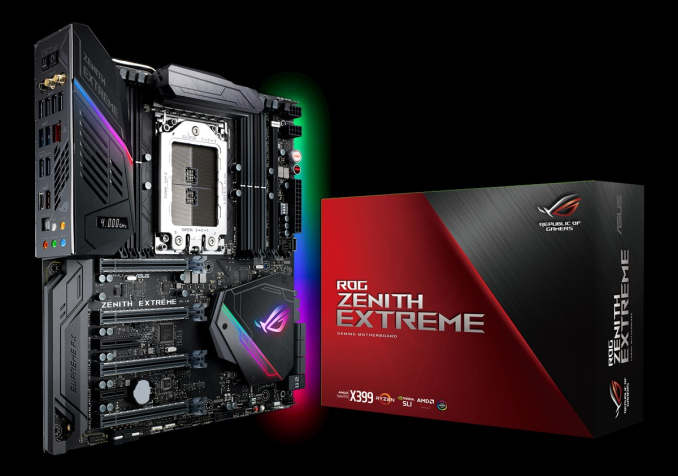
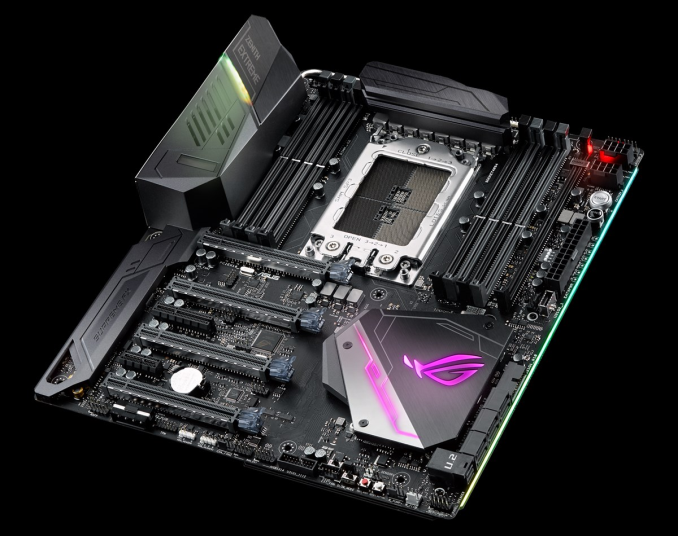
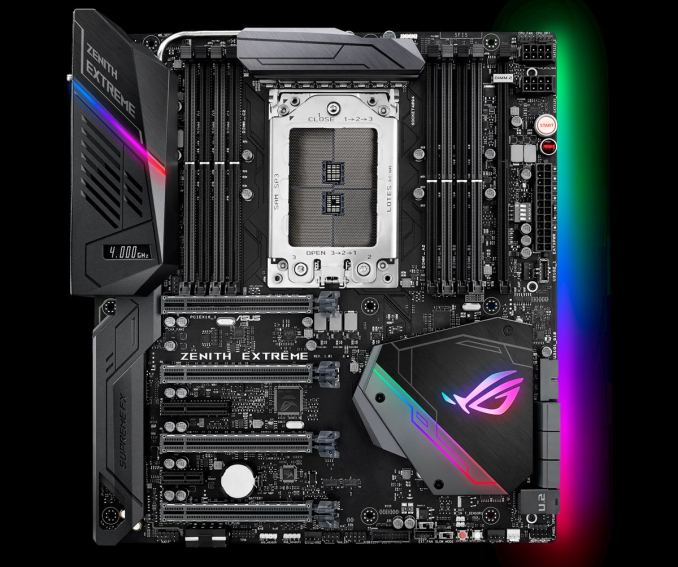




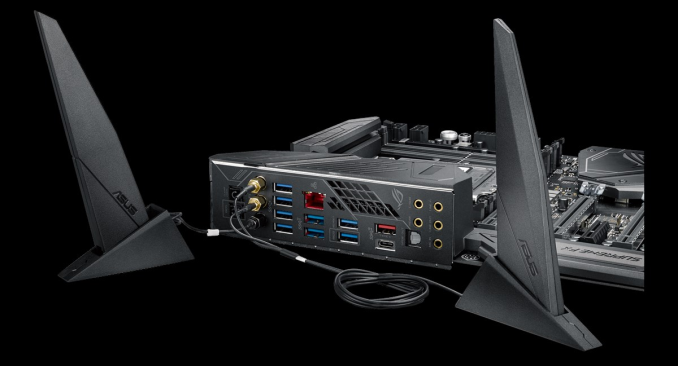
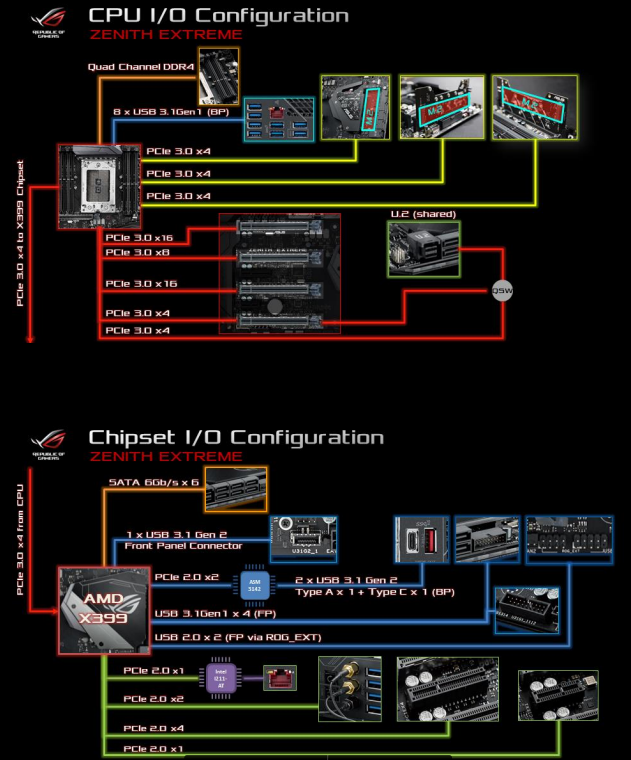








99 Comments
View All Comments
vgray35@hotmail.com - Saturday, September 16, 2017 - link
A few % better - you are looking at it wrong. Platinum PSU units with peak 94% efficiency means 6% heat dissipated. Now at 99% efficiency that is 1% dissipated as heat. That means a 5/6th reduction in heat or 83% less heat which is not just a few percent better. Further the new topology yields a >70% cost reduction which is also not insignificant. Gas turbines are also too noisy by the way, which is the main reason these are not considered (expensive when they go wrong too), and thus not a good comparison versus improvements being discussed here. Are you saying the linked article on PWM-resonance and resonance scaling topology is not worthwhile, or the problems with Buck converter inductors is not a severely limited and highly noisy power solution? Perhaps Power Electronics engineering is not your field of interest at all!Manch - Monday, September 18, 2017 - link
ICE is not 60% less efficient than a gas turbine. A gas turbine doesn't scale downward well. One of similar power would actually less efficient as an equivalent rated ICE. Gas turbines are impractical for vehicles.One benefit of a turbine would be no tailgating. The intake would suck in and crap out small critters all over your windshield.
vgray35@hotmail.com - Friday, September 15, 2017 - link
Yes I appreciate that - we draw power (Watts) at the rate of Joules of energy per second, Notice I said "we draw power", but that is also directly reflected proportionally as current in Amps (or a rate of Coulombs per sec), There was not a direct inference that power is measured in Amps, but only (a) "We are drawing a measure of power", and (b) this is approaching proportionally a resultant 150A. Yes I probably could have said better, but in wise did I say power is measured in AMPS.vgray35@hotmail.com - Friday, September 15, 2017 - link
I do not believe a defacto motto of the industry is "we are wasting 5% in heat, so let us not bother with wasting only 1%). Clearly you did not read the link to the Power Electronics article (I surmise), as then you would have realized the solution offers a huge reduction in cost as well as heat. The cost factor is something everybody is interesting in, even the industry at large, in my humble opinion.ddriver - Friday, September 15, 2017 - link
Huge? Like what? 6-7% better? Maybe 8-9%?What I meant is the solution you linked to is like 99% efficient, a good buck converter is what? Like 90-92%?
That's nowhere near the difference between an internal combustion engine and a gas turbine, the latter being more than twice more efficient. And still no adoption, even thou the solution is not really all that complex, and decades old. They still only use gas turbines in the most demanding applications, which is pretty much the same as with the converters from that article, which that dude developed for NASA's most demanding applications. I am pretty sure computers in NASA run on buck converters too, and they will use his designs only for the stuff they launch into space.
You probably don't realize how immense of an impact it would have if all cars on the planet become more than twice as efficient, burning more than twice as little fuel, outputting less than half the harmful emissions, traveling twice as far on a single fill. It would completely dwarf the benefits of boosting computer power converters from 90 to 99% :)
I am not saying it is not cool, I am just saying there have been a lot more beneficial a lot more high priority solutions that haven't been adopted yet for a lot longer, so you should not be surprised that the entire industry hasn't switched to a new power converter design overnight. They will do as they will always do, they will milk the cow until it dies, and then make it into jerky, and only then will then go for the new and better thing.
vgray35@hotmail.com - Saturday, September 16, 2017 - link
As noted earlier, 92% which is 8% heat versus 99% which is 1% heat means a 7/8th reduction in heat or 87% reduction. Thinking this is only a 7% improvement differential is incorrect - it is in this example an 87% improvement. That is not small potatoes. When this is coupled with a corresponding large cost reduction, then it becomes apparent the chip manufacturers would rather make more money using the older technology. Maybe the PSU engineers are just plain lazy or are not following the advances in their field as they are snowed under with work.Let's keep the discussion focused on power supplies.vgray35@hotmail.com - Saturday, September 16, 2017 - link
The 600W @ 12V fed to the motherboard with ~8% losses is ~50W heat in the VRMs (driving 180W CPU, 320W GPU, leaving 100W for other parts), The ATX power supply is 90% efficient or less with 60W heat also in the same case. The GPU power supply also is another 25W waste power supply heat, for a total of 135W of waste heat (as opposed to the useful heat generated within the various components themselves, which is heat generated from useful work being done). It is tough to manage this 660W in the case, but over 135W of it (>21% low ball estimate) is waste heat from just power supplies alone (ATX PSU, VRMs, GPU supply), of which over 80% or 110W could be eliminated by abandoning the Buck converter topology. This of course is a simplistic view, as there are other components too that are ignored here, for brevity's sake. I suspect >25% of heat comes from power supplies alone which can be dramatically curtailed. It's a 3 ringed circus: ATX PSU steals 10% for itself, motherboard steals another 8% for itself and GPU steals a further 8% for itself. We have no control over the power drawn from the mega chips themselves, but we do have control over the power supplies that drive them, and manufacturers could be doing a lot better here. And this is by no means a monster power hungry system with only one high-end graphics card. A >85% reduction in power supply waste heat can be realized if the Buck converter is abandoned, and that applies to resonant LLC power supplies also. The motherboard manufacturers and ATX PSU manufacturers need to take this aspect much more seriously.http://www.powerelectronics.com/power-management/s...
AMD's Thread Ripper X399 and Intel's X299 platforms should have been their first attempt at abandoning the Buck, half-bridge, and resonant LLC topologies. They failed us in that regard. We need this fiasco to come to an end by using hybrid PWM-resonant switching and resonance scaling, which eliminates the ferrite cored inductors altogether, and replaces them with just copper traces on the PCB. This is not rocket science.
Oxford Guy - Saturday, September 16, 2017 - link
Motherboard makers seem pretty much incompetent. They can't even be bothered to issue BIOS updates to fix serious bugs.ddriver - Sunday, September 17, 2017 - link
Yeah, but then again, an overclocked TR is like 200W, even an entry level car is like 200 KILOWATTS. So percentages are not really that much indicative.The facts remain. A TR mobo with a better power regulator circuit will save like 10 watts of power, a car with a gas turbine engine will save like 100 KW of power.
That's 10 000 times larger saving measured on absolute scales. What's more important in your opinion? Saving a watt, or saving 10 000 watts? Naturally, I'd rather have both. The goal here is to illustrate how low of a priority it is to improve mobo power delivery compared to some other, longer standing improvement opportunities that have been ignored.
Icehawk - Sunday, September 17, 2017 - link
They tried turbine cars, they are terrible due to the way they deliver power. Several successful drag cars have used them as in that application the power delivery works well. Same reason we aren't going to be driving rocket cars.